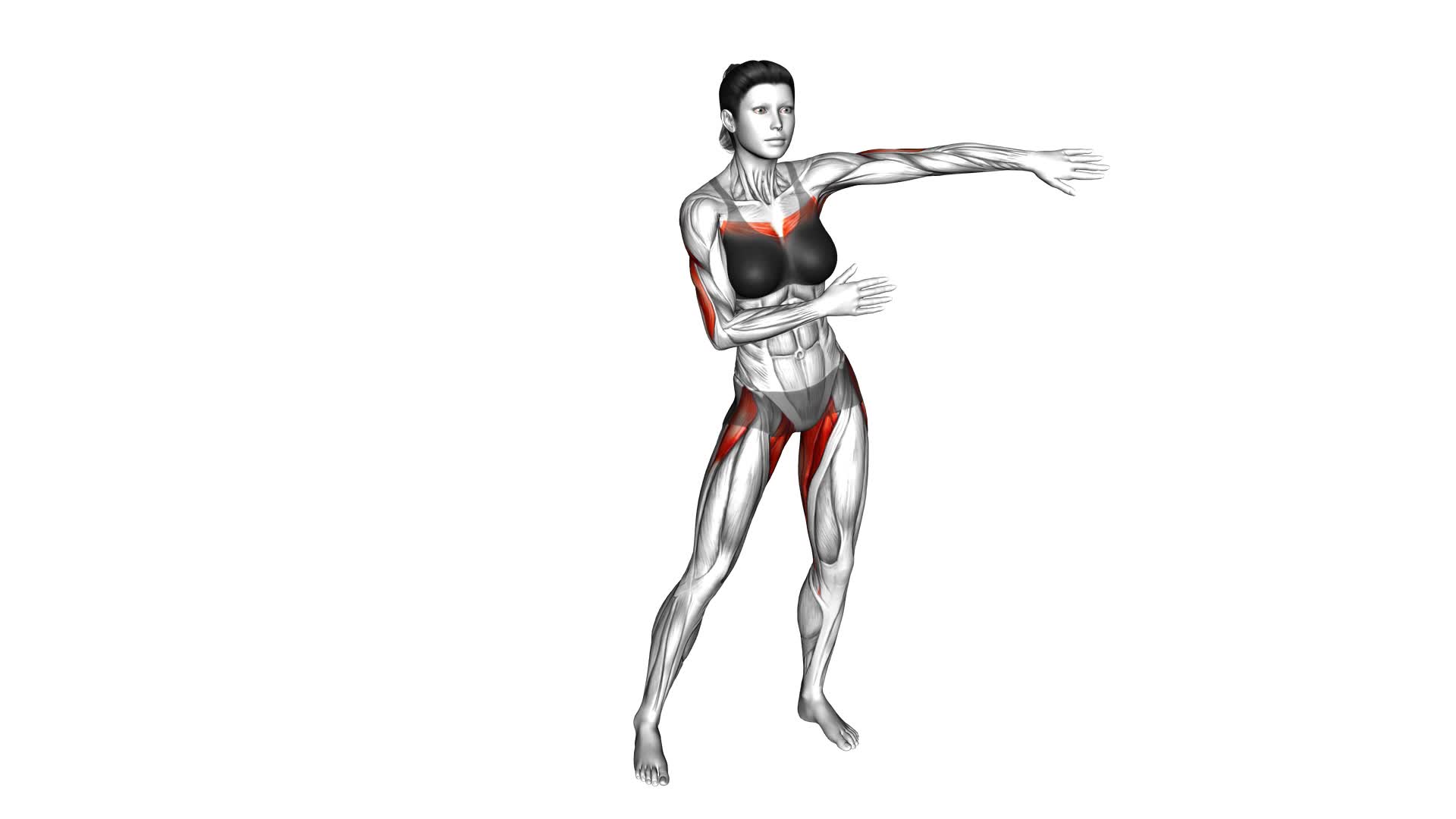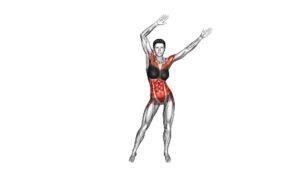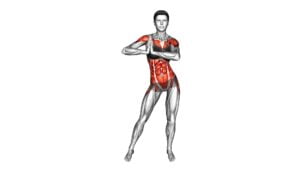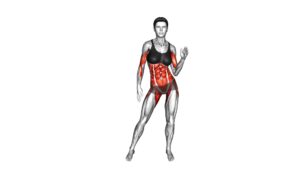Standing Hip Frontal Rotation With Shoulders Adduction (Female) – Video Exercise Guide & Tips

Incorporate the Standing Hip Frontal Rotation With Shoulders Adduction exercise into your workout routine for a targeted lower body and shoulder workout.
Watch This Exercise Video
This video exercise guide provides step-by-step instructions and tips to ensure proper form and technique.
Avoid common mistakes and discover modifications and progressions to challenge yourself at any fitness level.
Enhance your strength and mobility with this effective exercise.
Key Takeaways
- The Standing Hip Frontal Rotation With Shoulders Adduction exercise improves hip mobility and strengthens shoulder muscles.
- It targets muscles in the hips and shoulders, increasing flexibility and overall strength.
- Proper form and technique involve starting with feet shoulder-width apart, rotating one hip outward while bringing the same-side shoulder across the body, engaging the core, and maintaining a neutral spine.
- Modifications and progressions include incorporating different resistance levels, increasing range of motion, and using resistance bands or weights.
Benefits of the Standing Hip Frontal Rotation With Shoulders Adduction Exercise
You will experience improved hip mobility and strengthened shoulder muscles by incorporating the Standing Hip Frontal Rotation With Shoulders Adduction exercise into your workout routine. This exercise specifically targets the muscles in your hips and shoulders, helping to increase their flexibility and strength.
The standing hip frontal rotation with shoulders adduction exercise primarily engages the hip abductors, which are responsible for moving your leg away from your body, and the hip adductors, which bring your leg back towards the midline of your body. By performing this exercise, you can effectively target and strengthen these muscles, improving your overall hip mobility.
Additionally, this exercise also engages the muscles in your shoulders. The adduction movement, where you bring your arms towards the midline of your body, activates the muscles in your shoulders, specifically the deltoids and the pectoralis major. By incorporating this exercise into your routine, you can develop stronger and more stable shoulder muscles.
Before performing the standing hip frontal rotation with shoulders adduction exercise, it's important to properly warm up your body. This can include light cardio exercises such as jogging or jumping jacks, as well as dynamic stretches that specifically target the hips and shoulders. Warming up helps to increase blood flow to the muscles, reducing the risk of injury and preparing your body for the exercise ahead.
Proper Form and Technique for the Standing Hip Frontal Rotation With Shoulders Adduction Exercise
To ensure proper form and technique for the Standing Hip Frontal Rotation With Shoulders Adduction exercise, it's important to follow these guidelines.
First, it's a common misconception that this exercise is only for females. In reality, both males and females can benefit from this exercise, as it targets the muscles in the hips and shoulders, helping to improve overall stability and mobility.
To perform the exercise correctly, start by standing with your feet shoulder-width apart and your arms extended out to the sides. Next, rotate one hip outward while simultaneously bringing the same-side shoulder across your body. Make sure to engage your core and maintain a neutral spine throughout the movement.
It is important to note that there are variations and alternatives to this exercise. If you have difficulty maintaining balance, you can perform the exercise while holding onto a stable surface, such as a wall or chair. Additionally, you can use resistance bands or weights to add intensity to the exercise.
By following these guidelines and understanding the common misconceptions, as well as exploring variations and alternatives, you can ensure that you're performing the Standing Hip Frontal Rotation With Shoulders Adduction exercise with proper form and technique.
Remember to consult with a fitness professional if you have any concerns or questions.
Modifications and Progressions for the Standing Hip Frontal Rotation With Shoulders Adduction Exercise
To modify or progress the Standing Hip Frontal Rotation With Shoulders Adduction exercise, consider incorporating different resistance levels or increasing the range of motion. Progressions can be made by using resistance bands or weights to add more challenge to the exercise. Start with a lighter resistance and gradually increase it as you get stronger. This will help to further activate the muscles in your hips and shoulders.
Another way to modify the exercise is by increasing the range of motion. You can do this by extending your leg further out to the side during the hip rotation or by bringing your shoulder blades closer together during the shoulder adduction. These modifications will intensify the exercise and target your muscles in different ways.
On the other hand, if you find the exercise too challenging, there are modifications you can make to simplify it. You can decrease the resistance or range of motion to make it more manageable. For example, you can use a lighter resistance band or perform smaller hip rotations and shoulder adductions.
By incorporating progressions or modifications, you can tailor the Standing Hip Frontal Rotation With Shoulders Adduction exercise to your fitness level and goals. This will help you achieve better results and prevent plateaus in your training.
Now, let's move on to the next section and discuss common mistakes to avoid during the exercise.
Common Mistakes to Avoid During the Standing Hip Frontal Rotation With Shoulders Adduction Exercise
One common mistake to avoid during the Standing Hip Frontal Rotation With Shoulders Adduction exercise is improper alignment of the hips and shoulders. This can lead to ineffective execution of the movement and potential risk of injury.
Here are some other common mistakes to watch out for:
- Allowing the hips to rotate too far forward or backward: It's important to maintain a neutral position of the hips throughout the exercise to ensure proper activation of the hip muscles.
- Shrugging the shoulders: Keep your shoulders relaxed and avoid lifting or tensing them during the movement. This will help maintain proper alignment and prevent unnecessary strain on the shoulders.
- Using excessive momentum: Avoid using momentum to rotate the hips and shoulders. Instead, focus on controlled and deliberate movements to effectively target the muscles involved.
- Failing to engage the core: Proper core engagement is crucial for stability during the exercise. Make sure to activate your core muscles by drawing your belly button towards your spine throughout the movement.
- Neglecting proper breathing technique: Remember to breathe steadily and avoid holding your breath. Inhale as you prepare for the movement and exhale as you rotate the hips and shoulders.
By avoiding these common mistakes, you can perform the Standing Hip Frontal Rotation With Shoulders Adduction exercise safely and effectively.
Now, let's move on to the next section and explore some tips for incorporating this exercise into your workout routine.
Tips for Incorporating the Standing Hip Frontal Rotation With Shoulders Adduction Exercise Into Your Workout Routine
To incorporate the Standing Hip Frontal Rotation With Shoulders Adduction exercise into your workout routine, focus on maintaining proper alignment of the hips and shoulders throughout the movement. This exercise can be a great addition to your routine as it targets the muscles in your hips and shoulders, helping to improve stability and mobility.
When incorporating this exercise, it's important to start with lighter weights or resistance bands to ensure proper form and technique. As you become more comfortable, you can gradually increase the weight or resistance to challenge yourself.
To add variety to your routine, you can incorporate variations of this exercise. One variation is to perform the movement in a seated position using a cable machine or resistance band. This can provide a different stimulus to your muscles and help to further strengthen and stabilize the hips and shoulders.
No equipment is needed for this exercise, making it convenient to incorporate into your routine. However, if you have access to a cable machine or resistance bands, you can use them to add resistance and increase the intensity of the exercise.
Remember to always listen to your body and modify the exercise as needed. If you experience any pain or discomfort, stop the exercise and consult with a fitness professional. Incorporating the Standing Hip Frontal Rotation With Shoulders Adduction exercise into your workout routine can help improve your overall strength and stability in the hips and shoulders.
Frequently Asked Questions
How Many Calories Does the Standing Hip Frontal Rotation With Shoulders Adduction Exercise Burn?
To find out how many calories you burn during the standing hip frontal rotation with shoulders adduction exercise, it's important to consider factors such as your weight, intensity, and duration of the exercise.
This exercise primarily targets the hip and shoulder muscles, helping to improve flexibility and strength.
To modify the exercise, you can use lighter weights or perform the movement without any added resistance.
Remember to consult a fitness professional to determine the most accurate calorie burn for your specific circumstances.
Can This Exercise Help Improve Posture?
Yes, incorporating rotational exercises into your workout routine can certainly help improve your posture.
By performing the standing hip frontal rotation with shoulders adduction exercise, you can strengthen the muscles in your hips and shoulders, which are crucial for maintaining proper alignment and posture.
This exercise targets the external and internal rotators of the hip, as well as the muscles in the shoulder girdle, promoting stability and balance.
Make sure to follow the proper technique to maximize the benefits of this exercise.
Is It Necessary to Use Weights or Resistance Bands for This Exercise?
Using weights or resistance bands for this exercise isn't necessary, but it can provide an extra challenge and help increase strength. For beginners, it's recommended to start without any added weight and focus on mastering the form.
Advanced exercisers can try using weights or resistance bands to intensify the workout.
This exercise is great for improving core strength, as it targets the hip muscles and engages the shoulders.
To ensure proper form, avoid common mistakes such as leaning forward or rotating the shoulders too much.
Can the Standing Hip Frontal Rotation With Shoulders Adduction Exercise Be Done by Individuals With Knee or Hip Problems?
Yes, the standing hip frontal rotation with shoulders adduction exercise can be modified for individuals with knee or hip problems.
If you have knee or hip issues, you can perform this exercise with lighter weights or resistance bands to reduce the stress on your joints.
This modification will help you strengthen your hips and shoulders without aggravating any existing conditions.
Additionally, athletes can benefit from this exercise as it improves hip stability and shoulder strength, enhancing overall performance.
How Often Should the Standing Hip Frontal Rotation With Shoulders Adduction Exercise Be Performed for Optimal Results?
For optimal results, you should perform the standing hip frontal rotation with shoulders adduction exercise regularly. The frequency of this exercise will depend on your fitness level and goals.
It's generally recommended to include this exercise in your routine 2-3 times per week. However, it's important to listen to your body and not overdo it, especially if you have any knee or hip problems.
Consulting with a fitness professional can help determine the best frequency for you.
Conclusion
Incorporating the standing hip frontal rotation with shoulders adduction exercise into your workout routine can provide numerous benefits, such as improved hip mobility and core stability.
It's important to maintain proper form and technique to maximize the effectiveness of the exercise and prevent injury.
By avoiding common mistakes and gradually progressing with modifications, you can enhance your overall strength and flexibility.
Add this exercise to your fitness regimen for a well-rounded workout that targets multiple muscle groups.

Author
Years ago, the spark of my life’s passion ignited in my mind the moment I stepped into the local gym for the first time. The inaugural bead of perspiration, the initial endeavor, the very first surge of endorphins, and a sense of pride that washed over me post-workout marked the beginning of my deep-seated interest in strength sports, fitness, and sports nutrition. This very curiosity blossomed rapidly into a profound fascination, propelling me to earn a Master’s degree in Physical Education from the Academy of Physical Education in Krakow, followed by a Sports Manager diploma from the Jagiellonian University. My journey of growth led me to gain more specialized qualifications, such as being a certified personal trainer with a focus on sports dietetics, a lifeguard, and an instructor for wellness and corrective gymnastics. Theoretical knowledge paired seamlessly with practical experience, reinforcing my belief that the transformation of individuals under my guidance was also a reflection of my personal growth. This belief holds true even today. Each day, I strive to push the boundaries and explore new realms. These realms gently elevate me to greater heights. The unique combination of passion for my field and the continuous quest for growth fuels my drive to break new ground.







